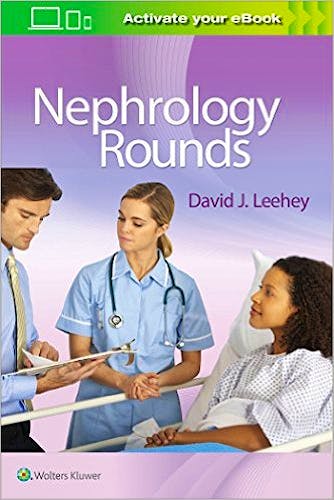

No hay productos en el carrito



Nephrology Rounds
Leehey, D.
1ª Edición Febrero 2016
Inglés
Tapa blanda
174 pags
300 gr
16 x 24 x null cm
ISBN 9781496319708
Editorial WOLTERS KLUWER
LIBRO IMPRESO
-5%
54,08 €51,38 €IVA incluido
52,00 €49,40 €IVA no incluido
Recíbelo en un plazo de
2 - 3 semanas
Description
How should changes in plasma creatinine be interpreted?
What is a fractional excretion, and how does measuring it help in clinical practice?
Is it helpful to diagnose a triple acid-base disturbance, or is it just a mental
exercise?
Focusing on the areas that are particularly challenging for trainees, Dr. David
Leehey presents 20 of the most perplexing and clinically relevant nephrology
questions faced by medical students, residents, and nephrology fellows and attendings.
His three decades of teaching experience provide real-world perspective on topics
such as complex acid base disturbances, sodium concentration disorders, and
the utility of urine anion and osmolal gaps. This concise title is an excellent
teaching and learning tool for anyone who needs expert insight on this often-difficult
subspecialty of medicine.
- Provides accurate, concise answers to 20 of today’s most difficult questions in nephrology.
- Pays particular attention to the principal concepts involved with each challenging nephrology question.
- Includes questions that involve controversy in treatment, such as the use of bicarbonate to treat metabolic acidosis and phosphorus binders to treat hyperphosphatemia.
Now with the print edition, enjoy the bundled interactive eBook edition, which can be downloaded to your tablet and smartphone or accessed online and includes features like:
• Complete content with enhanced navigation
• Powerful search tools and smart navigation cross-links that pull results
from content in the book, your notes, and even the web
• Cross-linked pages, references, and more for easy navigation
• Highlighting tool for easier reference of key content throughout the
text
• Ability to take and share notes with friends and colleagues
• Quick reference tabbing to save your favorite content for future use
Contents
1. How Is the Urinalysis Helpful in Patients with Kidney Disease?
2. How Should Changes in Plasma Creatinine Be Interpreted?
3. What Is a Fractional Excretion (and How Does Measuring It Help in Clinical
Practice)?
4. What Is the Urine Albumin to Creatinine Ratio? (Or Is It Protein to Creatinine
Ratio?)
5. What Is the Meaning of the Urine to Plasma Creatinine Ratio?
6. Is It Helpful to Diagnose a Triple Acid-base Disturbance? (Or Is It Just
a Mental Exercise?)
7. Why Are Disorders of Sodium Concentration so Difficult?
8. What Is Free Water Clearance and How Useful Is It?
9. How Does One Interpret the Urine Anion Gap and Urine Osmolal Gap?
10. Is It “Acute Renal Failure” or “Acute Kidney Injury”?
11. What Exactly Is Dialysis and When Is It Needed?
12. When Does Metabolic Acidosis Require Treatment with Bicarbonate?
13. Is There Any Advantage to Colloids Vs. Crystalloids for Volume Repletion?
14. Is Computed Tomography (CT) with Contrast or Magnetic Resonance Imaging
(MRI) with Contrast Preferred in Patients with Chronic Kidney Disease?
15. Is There a Risk to Rapidly Lowering the Plasma Potassium in Patients with
Hyperkalemia?
16. Should Calcium-based Phosphate Binders Be Used in Patients with Chronic
Kidney Disease?
17. Which Renal Cysts Require Follow-up Evaluation?
18. Are Renin Angiotensin Aldosterone System Blockers Friends or Foes of the
Kidneys?
19. Does a Patient with a Mild Decrease in Estimated Glomerular Filtration Rate
(eGFR) Really Have a Disease?
20. Why Are Kidney Stones a Nephrologic As Well As A Urologic Disease?
Author
David J. Leehey MD
Professor of Medicine
Loyola University of Chicago Medical Center
Maywood, Il
Associate Chief of Staff for Clinical Affairs
Veterans Administration Hospital
Hines, Il
© 2025 Axón Librería S.L.
2.149.0